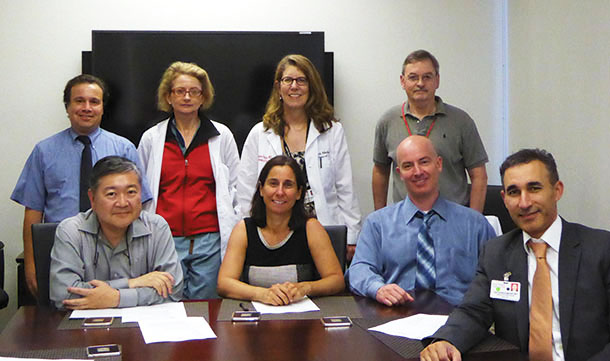Suzanne Palmer, MD, president of the Keck School of Medicine (KSOM) Faculty Council, is smiling as she talks about the pragmatic aspect of leading the 4-year-old group, which is the only elected body that represents the interests of the whole of the KSOM faculty.
In 2012, the members first reached out directly to peers — a practice that has continued — to solicit opinions about how best to expand their on-campus role and focus their energy to bring about meaningful change. The No. 1 concern?
“The food on the campus,” Palmer recalled with a chuckle. “And in 2013 it was updating the Edmondson Faculty Center.”
So the Council worked with USC Hospitality services and was successful in upgrading the food offerings and dining environments available on campus. Dealing with such practical concerns is just one aspect of the Council’s mission.
“The faculty members elect us to represent the faculty on matters of general associated concern,” said Palmer, professor of clinical radiology and medicine. “We play an advisory role to the administration within the school and also an important role in representing KSOM to the university as a whole.”
In 2014, members turned their attention to improving communication between the Health Sciences and University Park campuses by initiating a productive push to improve the visibility of the KSOM faculty and HSC at UPC.
“Out of sight, out of mind,” was the prevailing attitude on both campuses, Palmer said. “KSOM can feel far removed from UPC. Most faculty members don’t even know that we have a voice at the university.”
Every school at USC has a Faculty Council that sends members to represent their interests on the university-wide Academic Senate. Historically, the vast majority of Senate office-holders and leaders of various university committees have come from the UPC faculty.
But last year, when Paula Cannon, PhD, was the Keck School’s Faculty Council president, a concerted effort was made to get people from HSC — faculty from both the Keck School and the School of Pharmacy — involved in the Academic Senate and its subcommittees. They expected resistance. They found the opposite.
“Once we became more vocal at the Senate meetings, the UPC faculty and university leaders were absolutely open to our comments and suggestions,” Palmer said.
As it turned out, HSC representatives did more than simply add their voice to the Academic Senate. Soon, they were moving into leadership roles.
Cannon, professor of molecular microbiology and immunology and a leading stem cell researcher at the Keck School, was elected academic vice president. Next year Cannon will be the president of the USC Academic Senate. Two others from HSC — Associate Professor of Pediatrics Donna Elliott, MD, EdD, and Professor of Pharmacy Clay Wang, PhD — now are serving with Cannon on the Senate’s Executive Board.
“When we do get involved, HSC and CHLA faculty have a strong tradition of leadership within the USC faculty as a whole. In fact, I will be the third KSOM faculty member to be president since 2010, following Peter Conti (2010-11) and Charles Gomer (2013-14),” Cannon noted.
With KSOM representatives well-positioned to make a university-wide impact, Palmer wants to make sure the HSC and CHLA communities know about it.
For example, Cannon was recently announced as a member of a Sustainability Steering Committee that will implement a campuswide effort to reach 17 high-impact sustainability goals within the next five years.
“I think it’s really important that our faculty members know who we are and what we do,” Palmer said.
A group known as the Medical Faculty Assembly had existed in prior years, but the group became dormant until the fall of 2011 when it was restarted and renamed KSOM Faculty Council. Today, the Faculty Council consists of nine representatives (six clinical and three research) who serve for three years. The group regularly communicates with the Office of Faculty Affairs and the Dean, bringing forward problems and concerns identified by members of the faculty.
“Every year we want to identify at least one major issue that is important to the welfare of the Keck faculty,” Palmer said. “Our plans for this year include increasing the visibility of the Faculty Council at HSC and CHLA and supporting the on-campus movements to improve faculty wellness, professionalism and morale.
An important faculty survey will be conducted this month, Palmer said. Known as C-Change, this survey is used to measure the culture of academic health centers and provides direct comparison with national data. This tool has been used in more than 25 major U.S. academic centers and USC will be one of the first sites on the West Coast.
“This is a tool to quantify the concerns of our faculty and bring to light how people feel about the School of Medicine. We hope the entire faculty will participate in this survey,” Palmer said.
Palmer is also focusing her year as president on outreach. A big part of that effort will be the creation of a faculty-focused publication similar to the Research Quarterly that she expects to be distributed for the first time in April.
The faculty at CHLA will not be left out, Palmer said, noting that about one in four Keck School faculty members actually work at CHLA. “The HSC faculty sometimes forgets that the faculty members at CHLA are such a big part of the Keck School of Medicine.”
The content will be informational and practical, providing access to resources that Palmer said she wishes she had available when she first came to USC in 1997.
“We expect that the KSOM Clinical Quarterly will contain the up-to-date information we all should know regarding our clinical departments, including services available, their locations and personnel,” she said. “Information we all need regarding career development and promotion will also be included.”
— Les Dunseith


